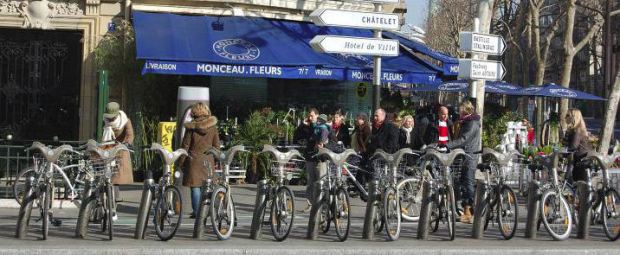 We are seeing some pretty good city-size public bike systems in cities like Paris, Barcelona, Lyon, and more recently Montreal — and more than fifty smaller systems, most of which in Europe and all doing a pretty fair job at what they have set out to do. That’s just fine. But what about the mega-cities of Latin America?
We are seeing some pretty good city-size public bike systems in cities like Paris, Barcelona, Lyon, and more recently Montreal — and more than fifty smaller systems, most of which in Europe and all doing a pretty fair job at what they have set out to do. That’s just fine. But what about the mega-cities of Latin America?
Will shared bike projects work out there? And if they are to have a shot at success how should they be planned, configured, implemented and then made to do the job day after day in the full stream of the continent’s exciting traffic and city life.
That was the issue that Eric Britton of the New Mobility Partnerships and World Streets was asked to address in an open brainstorm organized by the WRI EMBARQ team in Cuernavaca Mexico on 2 July 2009.
 * Click here for PowerPoint presentation: ecoplan.org/library/ws-embarq.ppt
* Click here for PowerPoint presentation: ecoplan.org/library/ws-embarq.ppt
Britton was asked specifically to report on the role that public or shared bike systems might eventually play in Latin American cities, against the background of their successful implementation for the most part in rather different environments. There has been considerable interest shown by politicians, some planners and transporters, public interest groups (mainly cyclists of course) and the media across the region over the last year or so. But how to move ahead with a concept which until now has been largely successful in European cities, under circumstances on the ground that differ considerably in most cases.
 * Click here for PowerPoint presentation: http://ecoplan.org/library/ws-embarq.ppt
* Click here for PowerPoint presentation: http://ecoplan.org/library/ws-embarq.ppt
“What next?” — Keep pedaling
This presentation represents his attempt to open up the discussions and at the same time to plant a few seeds. He looks for clues to what might be adapted and approached quite differently in these for the most part quite different environments. His closing message: Keep on pedaling, you can get there.
Reference:
World Public Bike Consortium at www.publicbike.newmobility.org (Offers extensive references and sources.)





















